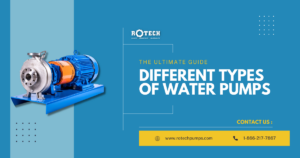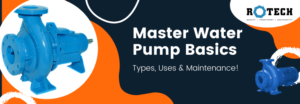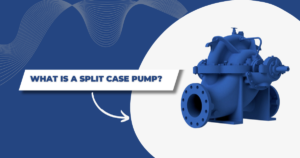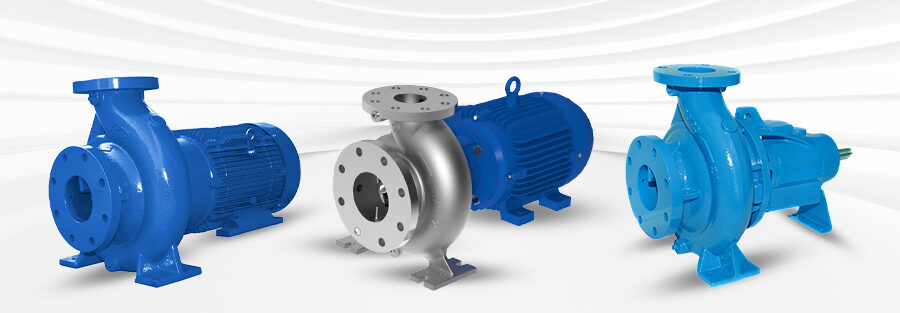Rotech Pumps & Systems is a leading manufacturer & Supplier of various types of pumps, mechanical seals, and valves. We call ourselves the pump people because we are passionate about providing apt pumping solutions and manufacturing the best quality products at competitive prices with minimum lead time. We help select precise pumps and systems as per your application needs. We get backed by an experienced team of engineers, a research and development technology center, and an in-house testing facility. We engage ourselves in designing and developing new products and customized pumps to meet clients’ requirements through our resources.
Rotech offers a massive range of end suction pumps. This article will briefly introduce you to the types and let you explore the functions, applications, and advantages of end suction pumps. An end-suction pump only has one impeller. The suction occurs from one side, and the discharge of the fluid occurs at the top at 90°. The velocity of the pumped fluid increases as it passes through the impeller. The diffusion transforms high velocity into high pressure before it gets excluded from the pump. End suction pumps are usually made of materials ranging from plastic and bronze to standard iron and even stainless steel. The construction entirely depends upon the applications of the pump.
End suction pumps are one of the most common types of pumps in the world. Their construction and design are simple when compared to their operations. End suction pumps are available in several types of materials with different sealing options. They are adaptive to handling corrosive and non-corrosive fluids for various applications. They can also handle tiny flows and pressures to large flows and moderate pressures. End suction pumps are usually designed as a back pull-out pump with a spacer coupling which facilitates maintenance without disturbing the alignment with the motor. Hence, they save on space and eliminate the need for motor alignment.
Types of End Suction Pumps
Close-Coupled End Suction Pumps
The close-coupled pumps get designed for the impeller to mount directly onto the end of the motor shaft, even if they are not the end-suction ones. And the pump casing attaches directly to the face of the motor. There are both benefits and limitations to this design.
The advantage is that the pump and motor never have to be aligned in the field with a close-coupled pump. The pump casing will be a registered fit to the face of the motor that ensures a proper alignment. In addition, close-coupled end-suction pumps are probably the most affordable pumps. The cost to replace them is often less than the cost to repair them. However, these pumps are immediately adjacent to the motor. So there is a higher risk of damage to the motor in the event of a seal failure.
Frame-Mounted End Suction Pumps
Frame-mounted end suction pumps get designed to be mounted next to a driver. The driver can be an electric motor on a usual baseplate coupled with a flexible coupling. Frame-mounted pumps integrate a bearing housing, unlike close-coupled pumps. The mounting feet are either placed under the bearing housing or the pump casing supporting the pump. Frame-mounted pumps are commonly available for several applications. Some manufacturers offer specialty end suction pumps that are significantly larger.
Advantages of End Suction Pumps
End Suction pumps are cost-effective, long-lasting, and ensure smoother operations. These pumps have a hydraulic design that provides high efficiency, a lower Net Positive Suction Head, and stable characteristics. End Suction pumps are also easier and faster to turn on and off. These pumps have a simple design with only a few moving parts. They do not have any valves and are easy to maintain.
An end suction pump is a cost-effective option for several industries when the output of the amount spent gets considered. They have compact designs as they only have one impeller used to move fluids from one end to the other. Hence, they do not take up a lot of space.
End suction pumps are highly advantageous. They get primed automatically when the fluid gets pumped. They are highly energy-efficient. The end-suction pump has the pressure of the liquid at the suction end to help it operate. You do not need to use so much energy to extract fluid from the pump. They are easy to maintain and are highly accessible.
Applications of End Suction Pumps
- Water treatment plants, chemical processing industries, food processing industries
- Water heaters, sprinklers, irrigation
- Water transfer in mines, construction sites, processing plants, large-scale industries, and processing plants among others
End Suction Pumps from Rotech
Horizontal Centrifugal End Suction Pumps
- 1600 series semi-open close-coupled pumps, DN series end suction pumps, DNJ series close-coupled end suction pumps
- RCP series end suction close-coupled pumps, RHS series split case pumps, RoChem CC series close-coupled pumps
- RoChem series frame-mounted pumps, Rotherm hot oil pumps, RST series end-suction close-coupled pumps
Self-Priming Centrifugal End Suction Pumps
- SCP series close-coupled pumps, SFP series frame-mounted pumps
- SPT/SXT series high-flow low-head solid handling trash pumps, SPU/SXU series high-head solid handling capability trash pumps
Recent Posts

A Comprehensive Guide to Types of Water Pumps and Their Applications
Introduction Water pumps are indispensable

The Complete Guide to Water Pumps: Types, Uses, and Maintenance
Water is life, and the

Comprehensive Guide to Split Case Pumps
Split case pumps are a


